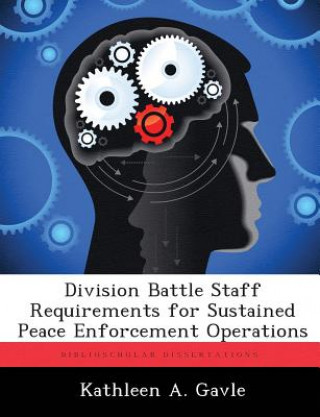
Kód: 08218349
Division Battle Staff Requirements for Sustained Peace Enforcement Operations
Autor Kathleen A Gavle
In December 1995, the Dayton Peace Accords led to a US Army deployment to Bosnia for participation in a complex, multinational peace enforcement mission, Operation JOINT ENDEAVOR. The 1st Armor Division led the first US force, Tas ... celý popis
- Jazyk:
 Angličtina
Angličtina - Väzba: Brožovaná
- Počet strán: 74
Nakladateľ: Biblioscholar, 2012
- Viac informácií o knihe

Mohlo by sa vám tiež páčiť
-

Dismantling Democracy in Venezuela
179.99 € -

Drugs and Behavior
193.60 € -

Black Dwarf
75.55 € -

Dam on the Homework River
31.63 € -

Arab Equitation
36.34 € -

Cancer Patience
18.42 € -4 % -

Literary Originality of the Gospel of Mark
47.50 €
Darčekový poukaz: Radosť zaručená
- Darujte poukaz v ľubovoľnej hodnote, a my sa postaráme o zvyšok.
- Poukaz sa vzťahuje na všetky produkty v našej ponuke.
- Elektronický poukaz si vytlačíte z e-mailu a môžete ho ihneď darovať.
- Platnosť poukazu je 12 mesiacov od dátumu vystavenia.
Viac informácií o knihe Division Battle Staff Requirements for Sustained Peace Enforcement Operations
Nákupom získate 172 bodov
 Anotácia knihy
Anotácia knihy
In December 1995, the Dayton Peace Accords led to a US Army deployment to Bosnia for participation in a complex, multinational peace enforcement mission, Operation JOINT ENDEAVOR. The 1st Armor Division led the first US force, Task Force Eagle, to occupy Multinational Division North, and three other divisions have since served as the nucleus of Task Force Eagle. This monograph examines the division battle staff in light of the experiences in Bosnia to assess whether the traditional battle staff structures and operations meet the demands of a peace enforcement operation. The monograph sets the stage for this examination by establishing the combat battle staff as the baseline for comparison and then describing the operational environment for peace enforcement. With this background, the monograph analyzes three specific aspects of the division battle staff experiences in Bosnia: staff functions, structures, and procedures. Three criteria measure staff effectiveness in coordinating or facilitating the division's response to the demands of the peace enforcement operational environment. One is the ability to eliminate hostilities and enforce a peace agreement. Second is the ability to deal with civilians, including local government and law enforcement, non-governmental organizations (NGO), and the media. Last is the ability to assess progress towards accomplishing military tasks that support the political end-state. The result of this analysis is an identification of key players, structures, and procedures to conduct peace enforcement operations. The fundamental requirements for the planning staff in peace enforcement operations are the same as those for the battle staff in a combat operation, but there are some significant refinements. The planning process still requires a chief planner, and feedback is still critical to drive and adapt the process. The military decision making process remains the best way to rationalize the work of the planners. The differences in the
 Parametre knihy
Parametre knihy
Zaradenie knihy Knihy po anglicky Society & social sciences Education
69.51 €
- Celý názov: Division Battle Staff Requirements for Sustained Peace Enforcement Operations
- Autor: Kathleen A Gavle
- Jazyk:
 Angličtina
Angličtina - Väzba: Brožovaná
- Počet strán: 74
- EAN: 9781286865767
- ISBN: 9781286865767
- ID: 08218349
- Nakladateľ: Biblioscholar
- Hmotnosť: 150 g
- Rozmery: 246 × 189 × 4 mm
- Dátum vydania: 01. October 2012
Obľúbené z iného súdka
-

Oxford IB Diploma Programme: IB Economics Course Book
62.24 € -

OET Preparation
10.43 € -

Cambridge IGCSE (R) & O Level Complete Physics: Student Book Fourth Edition
38.69 € -

Business Partner B2 Workbook
16.88 € -4 % -

Business Partner B1 Workbook
17.60 € -9 % -

Imagine If...
10.95 € -24 % -

OET Reading Subtest Preparation
12.79 € -7 % -

Vol 2 Blackletter Lettering Adventures
27.02 € -

AS & A Level Maths For Dummies
19.65 € -18 % -

CompTIA Security+ Review Guide - Exam SY0-601
26.41 € -20 % -

Hanbo Jutsu: Use of Hanbo, Cane and Walking Stick for Self Defense
11.66 € -

Amazing Autistic Brain Cards
42.07 € -

Embodied Teen
21.80 € -17 % -

Blue Book of Grammar and Punctuation: An Easy- to-Use Guide with Clear Rules, Real-World Examples , and Reproducible Quizzes, Twelfth Edition
16.99 € -20 % -

Positive Discipline Tools for Teachers
18.52 € -3 % -

Oxford IB Diploma Programme: IB Theory of Knowledge Course Book
57.94 € -

Oxford IB Study Guides: Economics for the IB Diploma
44.02 € -

Speed and Accuracy: Division
8.59 € -

GCSE Spanish Exam Practice Workbook (includes Answers & Free Online Audio)
7.98 € -10 % -

KS3 Maths 10-Minute Weekly Workouts - Year 7
8.08 € -9 % -

Vertical Academy
37.26 € -

Grade 9-1 GCSE Maths AQA Revision Question Cards - Higher
10.74 € -

Human Landscapes from My Country
27.94 € -4 % -

Cambridge IGCSE (R) & O Level Complete Chemistry: Student Book Fourth Edition
42.48 € -

Oxford IB Diploma Programme: IB Course Preparation Mathematics Student Book
41.15 € -

1000 TRIOS or gapped sentences for Cambridge Advanced and Proficiency Exams
25.07 € -

Business Partner B1+ Workbook
16.88 € -4 % -

(ISC) SSCP SG & SSCP Practice Test Kit, 3e
70.64 € -23 % -

Einkorn
20.77 € -21 % -

Czech Verbs
40.33 € -

Motivation and Reinforcement
46.99 € -

Pearson Edexcel International GCSE (9-1) English Language B Student Book
53.74 € -

Read Write Inc. Phonics: Red Ditty Book Bag Books (Mixed Pack of 10)
67.46 € -

Oxford International Primary Maths Second Edition: Practice Book 1
13.10 € -

Forensic Linguistics Articles
17.60 € -

Corrected Squares of The Book of Abramelin
612.06 € -

Exam Prep for Microeconomics by Pindyck & Rubinfeld, 6th Ed.
45.76 € -

KS3 Maths 10-Minute Weekly Workouts - Year 8
8.08 € -9 % -

Reading Mind - A Cognitive Approach to Understanding How the Mind Reads
24.05 € -20 % -

Ganzheitliche Sprachförderung
32.65 € -

Internet Protocol over Link-16
69.51 € -

Effect of Registration Errors on Tracking in a Networked Radar System
69.51 € -

Princeton Review SAT Premium Prep, 2021
46.17 € -

CEH v11 Certified Ethical Hacker Study Guide + Practice Tests Set
75.76 € -5 % -

10 Practice Tests for the SAT, 2021 Edition
34.19 € -

OCP Oracle Certified Professional Java SE 11 Programmer II Study Guide - Exam 1Z0-816 and Exam 1Z0-817
49.85 € -7 % -

Prepared
33.98 € -

Powerful Teaching: Unleash the Science of Learning
28.76 € -20 % -

Physics for You
57.43 €
Osobný odber Bratislava a 2642 dalších
Copyright ©2008-24 najlacnejsie-knihy.sk Všetky práva vyhradenéSúkromieCookies



 19 miliónov titulov
19 miliónov titulov Vrátenie do mesiaca
Vrátenie do mesiaca 02/210 210 99 (8-15.30h)
02/210 210 99 (8-15.30h)